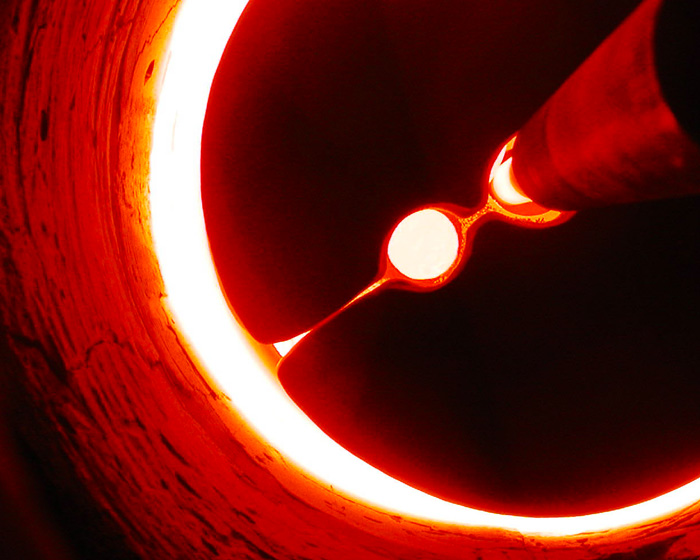Bringing back depleted uranium experiments at pRad
Studying metals and how they change

The Proton Radiography (pRad) Facility at the Los Alamos Neutron Science Center (LANSCE) hadn’t hosted depleted uranium experiments for more than a decade, but now they are making a comeback, thanks to a proposal from Lawrence Livermore National Laboratory scientists.
pRad, invented at Los Alamos, is valued for weapons research and stockpile stewardship activities. The technique leverages the LANSCE accelerator’s high-energy proton beam to capture images that reveal the properties and behavior of high explosives and the materials driven by them.

The experiments
The point of this work was to obtain useful images to study the evolution of fracture and fragmentation of various metals under dynamic loading conditions (forces and loads that change due to movement or acceleration). Dynamic loading conditions can alter the strength and behavior of materials.
Part of Livermore’s research supported the National Nuclear Security Administration’s (NNSA) efforts to modernize depleted uranium manufacturing by examining how different production processes affect the metal’s performance under dynamic conditions. Additionally, this research contributed to the W87-1 project, which represents the first newly manufactured nuclear warhead in three decades.
Can we do this?
To ensure the safety of workers, protect the facility, and enhance the success of the experiments, the proposal had to be revised every year for five years until the pRad team accepted it for execution.
Depleted uranium experiments are known to generate fragments that can damage the high-explosives vessel and equipment within the pRad dome, so the Livermore experimental team and the pRad team worked together to design and test a shielding package before the experiments could begin. In addition to testing the shielding package at an outdoor firing site at the Lab, the explosive operations sub-team, housed in Dynamic Experiments Division, resurrected the depleted uranium vessel and beamlines, which had been in storage for over a decade, and updated the procedures.
The turning point came in spring 2023, when Dynamic Experiments Division’s successful proof shot at the outdoor site confirmed the shot and shielding design could safely be executed in the pRad vessel. Following this, the first shot on a stainless-steel hubcap at pRad demonstrated the radiography team’s ability to capture high-quality images for Livermore’s research.
The happy customer
“The time-resolved radiographs and the enhanced spatial resolution were important for our research,” said Livermore materials scientist Amanda Wu. “The experiment yielded over 240 data files and required months of iteration between Livermore, Pacific Northwest, and Los Alamos scientists. The first of these hubcap series of shots conducted at pRad will yield valuable information, not just on the experimental calibration of fragmentation models, but also on the effect of material production methods.” Wu said her team hopes to do more shots at pRad in the near future.
What it took
This experiment took extra time. “In an effort to ensure this shot series happened, the accelerator’s run cycle was extended into January and February of 2024 when it usually ends at the end of December,” Mavis said.
Many pRad team members were new and still learning how it operates, which added to the challenge.
“There is often a single event that ensures success, but this was a massive effort by many people,” Mavis said. “It really does highlight how amazing and diverse the pRad team is, which includes Physics, Dynamic Experiments, Accelerator Operations and Technology, and Radiation Protection (and
so many others)!”
What’s next
“The success of the experiment has brought a lot of interest from other science teams to pursue depleted uranium experiments,” said Mary Sandstrom (Physics Division), who leads the pRad capability at LANSCE. “While this experiment was a great first step in the process of adding high-explosive-driven depleted uranium experiments back into the capability’s portfolio, we still have a lot of work to do.”

Stockpile Stewardship and Management Plan
In 1992, the United States declared a moratorium on nuclear weapons tests. Weapons in storage are damaged over time by their own radioactivity and need replacement parts.
The annual Stockpile Stewardship and Management Plan from NNSA to Congress outlines the work required to keep the nation’s stockpiled nuclear weapons in top condition without trying them out and to support new weapon development. Depleted uranium modernization, one priority in the plan, aims to overcome supply challenges and restore manufacturing capabilities for weapon components.
Depleted uranium is uranium from which most of the fissile isotope uranium-235 has been removed. It is required for nuclear component production to maintain and modernize the stockpile through life extension, modification, and limited life component exchange programs, according to the Stockpile Stewardship and Management Plan.



